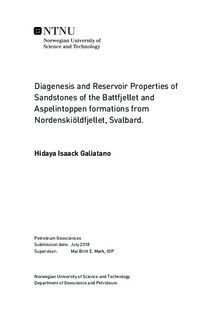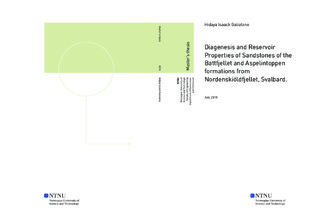| dc.description.abstract | The Battfjellet and Aspelintoppen formations have been studied with the aim of finding textural and mineralogical properties of the sandstones and relate them to diagenesis processes and reservoir properties. The study was conducted with the aid of petrographic studies, where thin section samples from the Nordenskiöldfjellet area were analyzed by optical light microscopy and Scanning Electron Microscopy. The estimation of porosity was conducted with Imagej software.
Sandstones of the Battfjellet and Aspelintioppen Formation are chemically and textural immature composed with abundant quartz grains, mica and chert fragments together with minor amounts of feldspar, pyrite, epidote, rutile and zircon. The sandstones were observed with angular to sub angular grains and poor degree of sorting.
Mechanical compaction is the main diagenetic features that affected the sediments during the time of deposition and in their progress burial. Mechanical compaction was found to have much effect on the sediments as the sandstones were observed composed with ductile metamorphic fragment which were easily deformed during the compaction, hence porosity loss in these sandstones is mainly caused by the mechanical compaction.
The Battfjellet Sandstones show diagenetic alteration of clay minerals where kaolinite and chlorite have been observed as the most dominant clay minerals. They were found as pore filling and replacive minerals. Other diagenetic cement which are the result of chemical compaction have been found in very small trace amounts whereas calcite, siderite and quartz cement were observed in the sandstone in both formations.
Porosity and permeability are the main features for a reservoir rock, and it is important to study these features to quantify the quality of the reservoir. Some of the Battfjellet Sandstones are characterized with coarse grains show a moderate to good porosity with good pore connectivity. The fine-grained sandstones of the Aspelintoppen Formation do not serve as good reservoir as they have been found with very low porosity. | |

